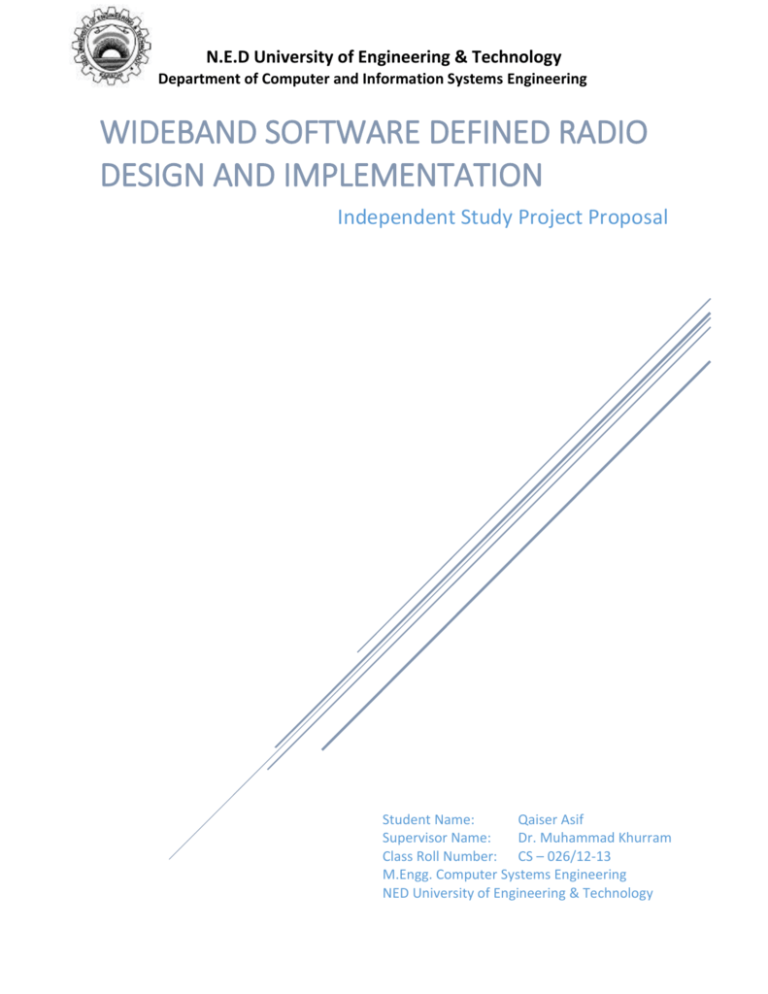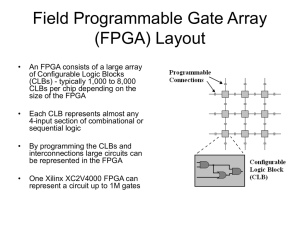Wideband Software Defined Radio design and
advertisement

N.E.D University of Engineering & Technology Department of Computer and Information Systems Engineering WIDEBAND SOFTWARE DEFINED RADIO DESIGN AND IMPLEMENTATION Independent Study Project Proposal Student Name: Qaiser Asif Supervisor Name: Dr. Muhammad Khurram Class Roll Number: CS – 026/12-13 M.Engg. Computer Systems Engineering NED University of Engineering & Technology N.E.D University of Engineering & Technology Department of Computer and Information Systems Engineering SUMMARY – Independent Study Project Title Supervisor Researcher Duration, Timeline Goals Wideband Software Defined Radio Design and Implementation Dr. Muhammad Khurram Qaiser Asif -- Roll # CS – 026/12-13, M.Engg, CIS Dept Spring Semester 2014 – M.Engg. (CS) 1. Complete the research work within the given time. 2. Submit the completed hardware and software 3. Submit a research report and a research paper Research Summary The primary goal is the design and development of an SDR platform and the software implementation of reconfigurable signal processing algorithms. In this project, wideband spectrum of signals between 88 to 108 MHz will be chosen to practically demonstrate the SDR concept. An RF frontend will be designed to condition the wideband RF signal. The conditioned RF signal will be fed to the fast analog to digital converter (ADC) frontend. An FPGA based reconfigurable and flexible digital frontend subsystem will be designed to interface the ADCs, provide reconfiguration mechanism, on FPGA signal queues for buffering, optional down conversion to digital intermediate frequency (IF). The FPGA will also provide the interface between FPGA and the General Purpose Processor (GPP) through PCI bus to ensure real time processing of radio samples. The software will be written on the GPP to perform complex communication functions using DSP techniques. 1 N.E.D University of Engineering & Technology Department of Computer and Information Systems Engineering Table of Contents 1. Introduction .......................................................................................................................................... 3 2. Motivation............................................................................................................................................. 3 3. Project Summary................................................................................................................................... 3 4. Project Methodology ............................................................................................................................ 4 4.1 Architecture .................................................................................................................................. 4 4.2 Signal Acquisition .......................................................................................................................... 4 4.3 Communication Interface with Host System ................................................................................ 5 4.4 System Software ........................................................................................................................... 5 5. Input Signal Specifications .................................................................................................................... 6 6. Project Deliverables .............................................................................................................................. 6 7. Timeline................................................................................................................................................. 6 8. Conclusion ............................................................................................................................................. 7 9. References ............................................................................................................................................ 7 10. Recommendations/Comments: ........................................................................................................ 9 2 N.E.D University of Engineering & Technology Department of Computer and Information Systems Engineering 1. Introduction The purpose of the software defined radio – SDR is to create a highly flexible and programmable wireless communication system in which the signal processing requirements can be dynamically modified to adjust to the changing needs and requirements. Software defined radio is the technology that enables to implement hardware circuits like Encoder/Decoder, Modulator/Demodulator and other communication circuits on a software execution platform utilizing digital signal processing (DSP) techniques. The software based implementation rather than hardware provides flexibility and programmability that can change the functionality of the system by just a software update. 2. Motivation The motivation for the SDR is the realization of the dynamic changes that will entirely change the future of wireless communication. As computational speeds increase, faster digital signal processors and digital conversion technologies are being developed. There is increased popularity of handheld devices and a growing dependency on mobile communication by public departments such as police, fire departments, military, and civil emergency response offices. The available bandwidth for this diverse customer base is finite. New technologies and protocols are the key to meet current and future demands. 3. Project Summary The primary goal is the design and development of an SDR platform and the software implementation of reconfigurable signal processing algorithms. In this project, wideband spectrum of signals between 88 to 108 MHz will be chosen to practically demonstrate the SDR concept . An RF frontend will be designed to condition the wideband RF signal. The conditioned RF signal will be fed to the fast analog to digital converter (ADC) frontend. An FPGA based reconfigurable and flexible digital frontend subsystem will be designed to interface the ADCs, provide reconfiguration mechanism, on FPGA signal queues for buffering, optional down 3 N.E.D University of Engineering & Technology Department of Computer and Information Systems Engineering conversion to digital intermediate frequency (IF). The FPGA will also provide the interface between FPGA and the General Purpose Processor (GPP) through PCI bus to ensure real time processing of radio samples. The software will be written on the GPP to perform complex communication functions using DSP techniques. 4. Project Methodology 4.1 Architecture A digital receiver mainly comprises of two parts. First is the analog part and the other part is the digital part. The analog part is the RF front end whose typical purpose is to receive the required signal, filter it and provide the signal sufficient strength so that it can easily be converted into digital words by means of ADCs. The digital part is used for IF signal processing of the signal. After the signal processing has been performed, the real time signal processing tasks will be handled in the software which requires a very high speed interconnection between the software and the baseband hardware which in this case will be a PCI bus. Figure 1: Basic block diagram of Software Defined Radio 4.2 Signal Acquisition The signal acquisition will be performed by the high speed ADCs mounted on Xtreme DSP kit IV. There are two ADC channels present on board. Each equipped with AD6645 ADC from Analog Devices. Their resolution is up to 14-bits and sampling rate is of 105 MSPS. The sampling rate is high enough to support wideband digitization. The ADCs are interfaced with the Xilinx Virtex-IV FPGA which will be programmed using Verilog HDL. 4 N.E.D University of Engineering & Technology Department of Computer and Information Systems Engineering 4.3 Communication Interface with Host System The high sampling rate A/D converters impose stringent requirements of a high speed interface between the reconfigurable hardware and the GPP to transfer the digital samples in real time. The high throughput requirement imposes two limitations in the existing GPP based workstations. First, the existing workstations do not have a high speed port to connect an RF frontend, creating a need to make a custom hardware. Second, the path between the device driver and application is rather inefficient, requiring modifications to the operating system. To cope up with this issue a first-in-first-out (FIFO) PCI will be designed. This interface is capable of providing high throughput data transfer to the GPP while maintaining the real time system requirement. After that it will be the responsibility of the application software to guarantee real time signal processing. Figure 2: Interface block diagram between Host PC and FPGA via PCI 4.4 System Software The software running on the GPP will be written in a high level language (e.g. C#, C++ etc.) running on Windows based platform. To ensure real time software execution, sample queues will be maintained both in the system main memory and the reconfigurable FPGA based digital frontend hardware. The software will be written such that any samples would not be lost and data integrity would be ensured. 5 N.E.D University of Engineering & Technology Department of Computer and Information Systems Engineering 5. Input Signal Specifications Following is the specifications of the signal Table 1: Signal Specifications Parameter Value Total Bandwidth - BW 20 MHz Lowest frequency - fL 88 MHz Highest frequency - fH 108 MHz Channel bandwidth - BWCH 20KHz Sampling rate 65 to 105 MSPS ADC quantization 14 bits 6. Project Deliverables The project deliverables are as follows: 1. Analog frontend to condition the RF signal of the antenna and prepare for digital conversion. 2. Reconfigurable digital frontend to process the RF signal using DSP techniques and to provide realtime interface to the GPP platform. 3. SDR software application. 4. A research report and a research paper in IEEE paper format. 7. Timeline The project goals have to be accomplished within the complete duration of Fall Semester 2014 of Master of Engineering (Computer Systems) programme. INCLUDE MONTHLY MILESTONES AND GANTT CHART HERE 6 N.E.D University of Engineering & Technology Department of Computer and Information Systems Engineering Elapsed time from S-No start (in months) Milestones Deliverables of the project 8. Conclusion In this project, a complete SDR, consists of analog and digital frontends and GPP based software running platform, will be designed and implemented. FM audio/music channels in the 88-108 MHz band will be received, processed and demodulated using SDR and DSP techniques. This research project will open up the possibilities for others to study and enhance this SDR platform in the department of Computer and Information Systems Engineering. 9. References 1. Muhammad Khurram and S. H. Mirza, "Wireless Transceiver Design Based on Software Defined Radio Technology" in 4th International Bhurban Conference on Applied Sciences & Tehnology, IBCAST, June 2005. 2. J. Mitola, “Software Radios Architecture”, IEEE National Communications Magazine, May 1995 3. Xavier Revés, Vuk Marojevic, Ramon Ferrús, Antoni Gelonch, “FPGA’S middleware for software defined radio applications” in Field Programmable Logic and Applications International Conference, 2005. 4. Alan C. Tribble, “The Software Defined Radio: Fact and Fiction” in Radio and Wireless Symposium, Orlando, FL, 2008 IEEE 5. Bhandari, S.U. ; Subbaraman, S. ; Pujari, S. “Digital Signal Modulator on FPGA using On the Fly Partial Reconfiguration” in Advances in Computing, Control, & Telecommunication Technologies, 2009. ACT '09. International Conference, Trivandrum, Kerala 7 N.E.D University of Engineering & Technology Department of Computer and Information Systems Engineering 6. Bo Li, “Analysis and Design of Software Defined Radio” in International Conference on Internet Computing and Information Services, 2011 7. A. I. Mecwan, N. P. Gajjar, “Implementation of Software Defined Radio on FPGA” in Engineering (NUiCONE), 2011 Nirma University International Conference. 8. Walter H.W. Tuttlebee, “Software Defined Radio: Enabling Technologies (Wiley Series in Software Radio)” 8 N.E.D University of Engineering & Technology Department of Computer and Information Systems Engineering 10. Recommendations/Comments: Supervisor: ______________________________________________________________________ ______________________________________________________________________ Post Graduate Research Committee: ______________________________________________________________________ ______________________________________________________________________ ______________________________________________________________________ ______________________________________________________________________ ______________________________________________________________________ M. Engg. Coordinator: ______________________________________________________________________ ______________________________________________________________________ Chairperson: ______________________________________________________________________ ______________________________________________________________________ Board of Studies: ______________________________________________________________________ ______________________________________________________________________ ______________________________________________________________________ _____________________________________________________________________ 9






